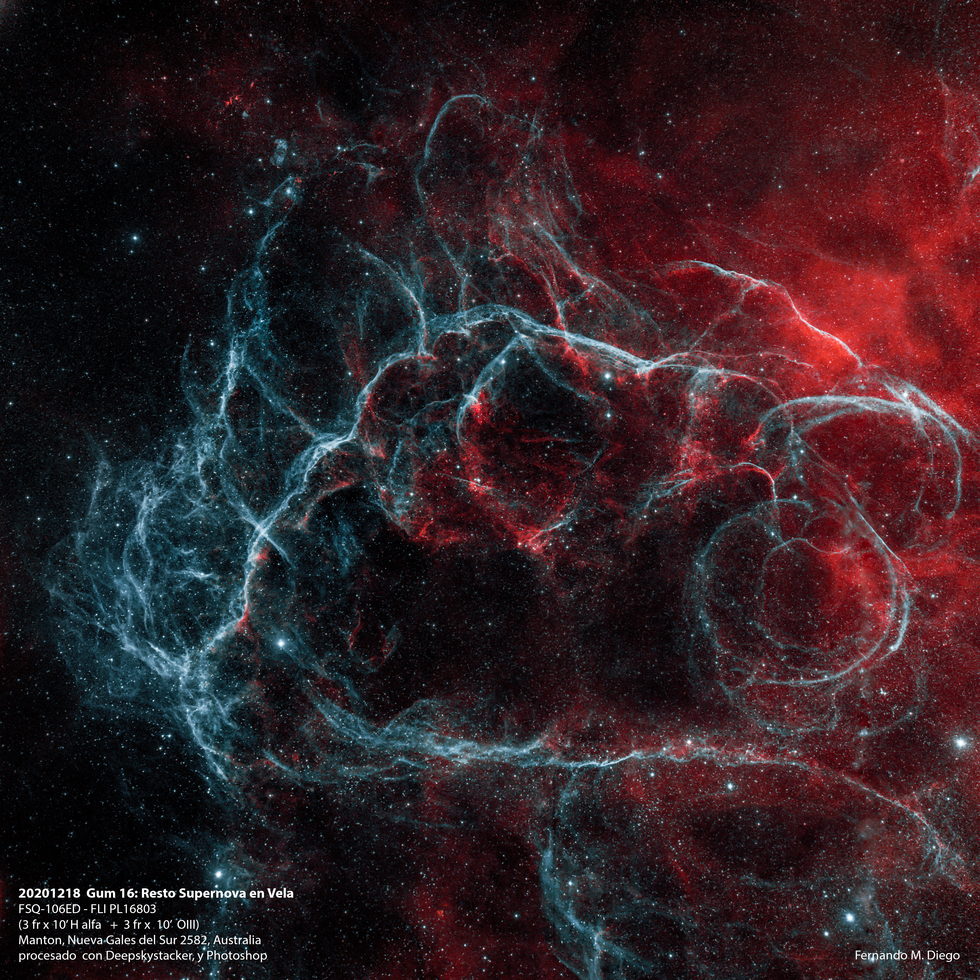Gum 16 - Vela Supernova Remnant
Gum 16 - Vela Supernova Remnant
The Vela supernova remnant is a supernova remnant in the southern constellation Vela. Its source Type II supernova exploded approximately 11,000–12,300 years ago (and was about 800 light-years away). The association of the Vela supernova remnant with the Vela pulsar, made by astronomers at the University of Sydney in 1968,[2] was direct observational evidence that supernovae form neutron stars.
The Vela supernova remnant includes NGC 2736. It also overlaps the Puppis A supernova remnant, which is four times more distant. Both the Puppis and Vela remnants are among the largest and brightest features in the X-ray sky.
The Vela supernova remnant (SNR) is one of the closest known to us. The Geminga pulsar is closer (and also resulted from a supernova), and in 1998 another near-Earth supernova remnant was discovered, RX J0852.0-4622, which from our point of view appears to be contained in the southeastern part of the Vela remnant. One estimate of its distance puts it only 200 parsecs away (about 650 ly), closer than the Vela remnant, and, surprisingly, it seems to have exploded much more recently, in the last thousand years, because it is still radiating gamma rays from the decay of titanium-44. This remnant was not seen earlier because in most wavelengths, it is lost because of the presence of the Vela remnant.[3]
The Vela supernova remnant includes NGC 2736. It also overlaps the Puppis A supernova remnant, which is four times more distant. Both the Puppis and Vela remnants are among the largest and brightest features in the X-ray sky.
The Vela supernova remnant (SNR) is one of the closest known to us. The Geminga pulsar is closer (and also resulted from a supernova), and in 1998 another near-Earth supernova remnant was discovered, RX J0852.0-4622, which from our point of view appears to be contained in the southeastern part of the Vela remnant. One estimate of its distance puts it only 200 parsecs away (about 650 ly), closer than the Vela remnant, and, surprisingly, it seems to have exploded much more recently, in the last thousand years, because it is still radiating gamma rays from the decay of titanium-44. This remnant was not seen earlier because in most wavelengths, it is lost because of the presence of the Vela remnant.[3]
SPECIFICATIONS
Telescope
Takahashi FSQ-106ED
Camera
FLI PL16803
Location
Manton Nueva Gales del Sur 2582, Australia
Date of observation
18/12/2020
Filters
H alpha & OIII
Processing
Deepskystacker & Photoshop
Comments
Superb!
great work



